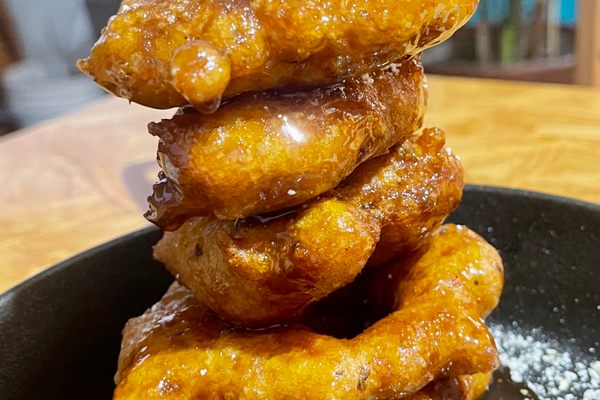Prepared Foods
Juane
Peru’s leaf-wrapped rice ball might be named after John the Baptist’s decapitated head.
Wherever you go in the Peruvian jungle, be it Tarapoto, Moyobamba, or Iquitos, you’re sure to see people selling and eating juanes. Wrapped in waxy bijao leaves, unopened juanes look like green, spherical (or sometimes brick-shaped) packages. Cut the string around the top and the leaf starts to unfurl, revealing a ball or block of yellow rice.
Inside the ever-so-slightly sticky mass you’ll typically find a piece of the yellow, fatty meat of an older hen (gallina) or, less traditionally, chicken, along with black olives and a boiled egg. The rice is flavored with herbs and spices that may include turmeric (palillo), cumin, oregano, salt, and pepper.
As for the origins of the dish’s name, there are two leading theories. According to one account, Spanish conquistadors and missionaries traveling in the jungle regions of Peru thought that the leaf-wrapped packages looked like the decapitated head of poor Saint John the Baptist (San Juan), who was executed by Herod.
San Juan is the patron saint of the Amazon, and extra-large juanes are traditionally served during the Festival of San Juan on June 24. During the festival, everyone goes to the riverside to swim, drink, and eat juanes. For many women, preparing the biggest, tastiest juane on June 24 can be a source of great pride. Families, friends, and neighbors often exchange juanes among themselves, so there’s plenty of culinary honor at stake.
The alternative origin story predates the arrival of the Spanish in the New World. This claims that indigenous river communities in the jungle, such as those of the Putumayo, Marañón, Huallaga, and Ucayali rivers, also cooked ingredients wrapped in bijao leaves. This cooking process was known as huanar in the local language. This, in turn, became huane and later juane.
It’s quite possible that there’s some truth in both these accounts. Like the Festival of San Juan—a Christian festival based on an older pre-Columbian celebration of the solstice—it’s a mix of Old and New World traditions. Spanish colonizers frequently tried to connect existing indigenous practices with the Catholic religion. That they’d try to alter the significance of a local dish to associate it with a Christian saint would come as no surprise at all.
Where to Try It
-
El Pichito
Jr. General Vidal 803, Breña, 15083, PeruYou can buy juanes at this jungle-food specialist in Lima.
-
El Encanto Amazonico
Av. Benavides 4001, Santiago de Surco, 15038, PeruAnother restaurant serving food from the jungle, including traditional juanes.
Written By
 Tony Dunnell
Tony Dunnell
Sources
- www.deperu.com/abc/productos-bandera/171/el-juane
- es.slideshare.net/quintanitah/historia-del-juane
- comidasperuanas.net/juane/
- howtoperu.com/the-festival-of-san-juan-peru/
- books.google.com/books?id=Wat9BAAAQBAJ&pg=PT81&dq=JUANE+PERUVIAN&hl=en&sa=X&ved=0ahUKEwjEj4KesojZAhXLuVkKHdbkDmsQ6AEILjAB#v=onepage&q=JUANE%20PERUVIAN&f=false
- www.latimes.com/food/jonathan-gold/la-fo-gold-review-rosaline-20170908-story.html
- www.chowhound.com/food-news/73739/pollo-or-gallina/


















